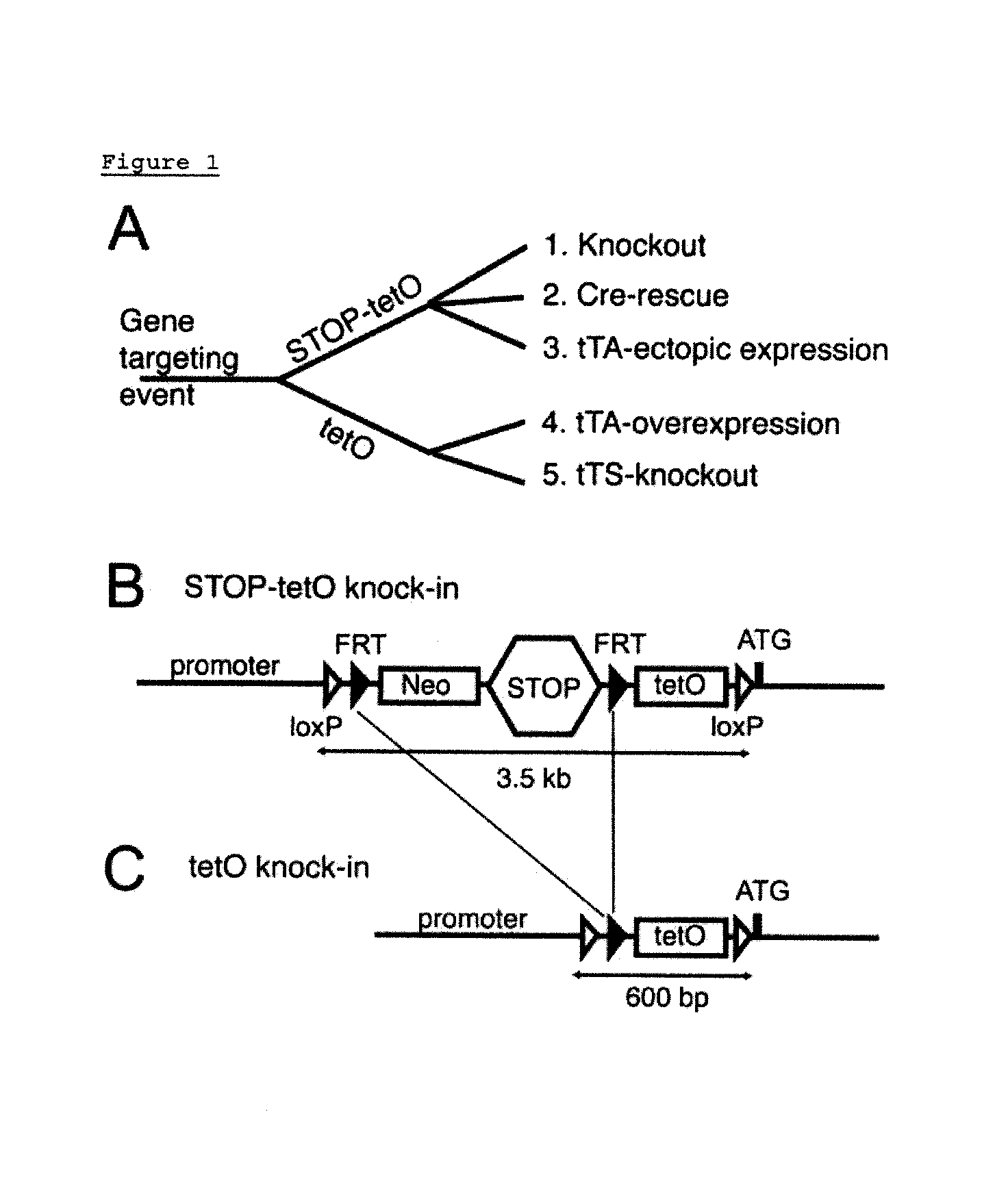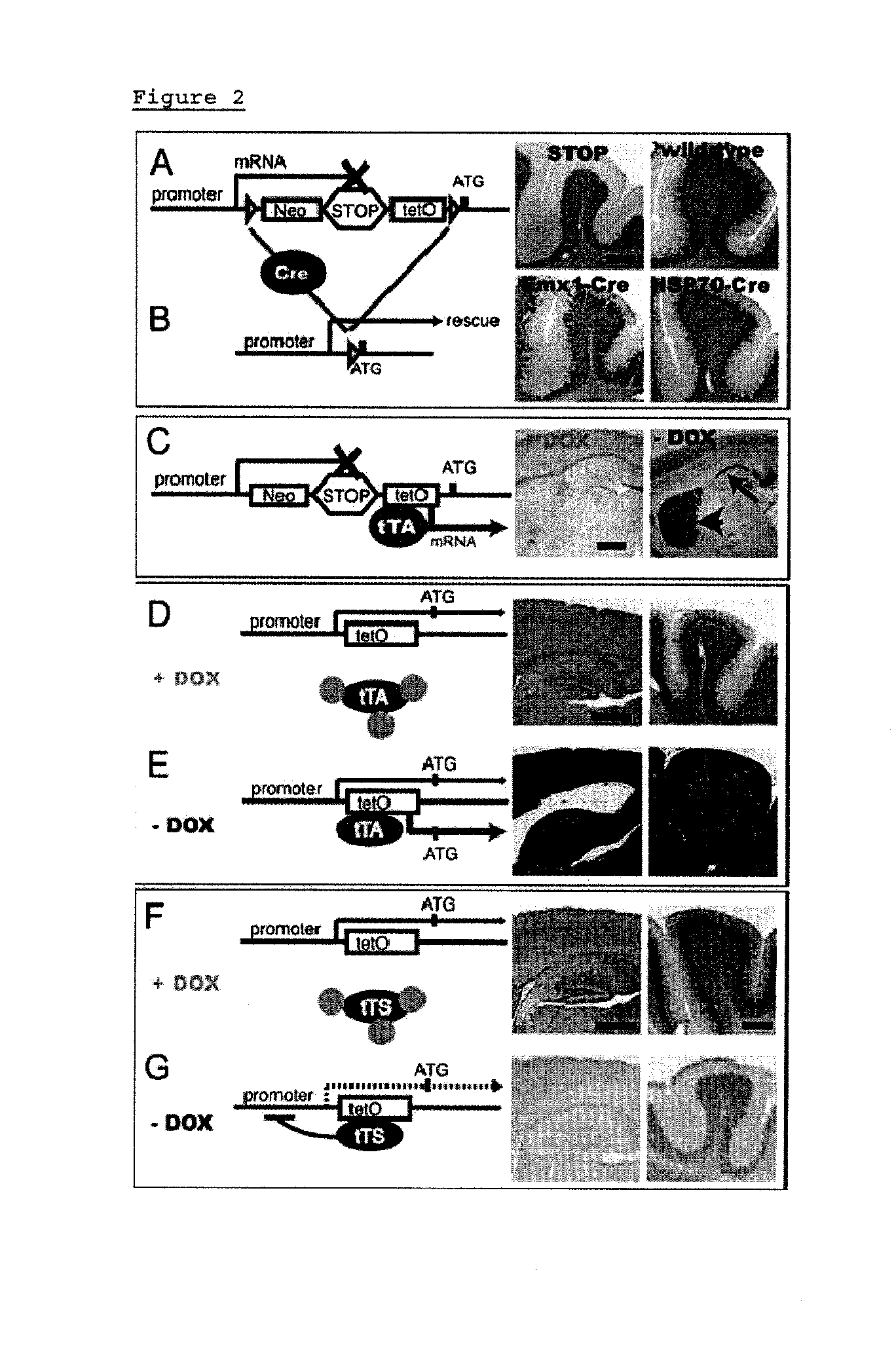In vivo gene regulation by the combination of knock-in-teto sequence into the genome and tetracycline-controlled trans-suppressor (TTS) protein
a technology of teto sequence and tetracycline, which is applied in the field of in vivo gene regulation, can solve the problems of reducing depression and anxiety, affecting behavior, and it is difficult to predict how changes in candidate gene expression patterns will affect behavior, so as to facilitate the integration of temporal and spatial specificity
- Summary
- Abstract
- Description
- Claims
- Application Information
AI Technical Summary
Benefits of technology
Problems solved by technology
Method used
Image
Examples
experiment 1
Yielding Two Distinct Mlc1 Mouse Lines: STOP-tetO and tetO Knock-in From a Single Gene Targeting Event
[0077]A single gene targeting event was achieved by inserting a loxP-FRT-Neo STOP-FRT-tetO-loxP cassette immediately upstream of the translation initiation site in exon 2 of the Mlc1 gene using conventional homologous recombination, resulting in Mlc1 STOP-tetO knock-in mice (FIG. 1B and FIG. 4). By crossing Mlc1 STOP-tetO knock-in mice with Flippase expressing mice (ROSA-Flpe mice) (6), the FRT-flanked Neo STOP minigene was removed through Flippase-FRT recombination. This cross yielded Mlc1 tetO knock-in mice (FIG. 1C).
experiment 2
Effect on Mlc1 Transcription in Mlc1 STOP-tetO Homozygous Mice
[0078]Mlc1 expression levels were examined at postnatal day 28 in mice. In wild type mice, Mlc1 mRNA was expressed only by astrocyte-lineage cells: astrocytes, Bergmann glia and ependymal cells (FIG. 2A and FIG. 6) as detected by in situ hybridization. In Mlc1 STOP-tetO homozygous mice, Mlc1 mRNA was not detected at any age examined, since the STOP sequence terminates transcription (7) driven by the endogenous Mlc1 promoter (FIG. 2A, FIG. 5, and FIG. 8). This indicates that STOP-tetO knock-in mice act like straight null mice.
experiment 3
Effect on Mlc1 Transcription in Mlc1 STOP-tetO Homozygous Mice Expressing Cre in Forebrain and in Germline
[0079]STOP-tetO knock-in mice permit 2 further manipulations: Cre-mediated rescue (FIG. 2B) and t-TA-mediated ectopic expression (FIG. 2C). To test Cre-mediated rescue, Mlc1 STOP-tetO mice were crossed with two established Cre lines: Emx1-Cre (10) (expresses Cre mainly in forebrain) and HSP70-Cre (11) (expresses Cre in germline). Mlc1 mRNA levels were then examined in the resulting homozygous STOP-tetO::Cre mice. Emx1-Cre-mediated recombination resulted in a partial rescue as illustrated by expression in the Bergmann glia (FIG. 2B); germline Cre-mediated recombination resulted in complete rescue (FIG. 2B) (8,9).
PUM
| Property | Measurement | Unit |
|---|---|---|
| pH | aaaaa | aaaaa |
| pH | aaaaa | aaaaa |
| speed | aaaaa | aaaaa |
Abstract
Description
Claims
Application Information
 Login to View More
Login to View More - R&D
- Intellectual Property
- Life Sciences
- Materials
- Tech Scout
- Unparalleled Data Quality
- Higher Quality Content
- 60% Fewer Hallucinations
Browse by: Latest US Patents, China's latest patents, Technical Efficacy Thesaurus, Application Domain, Technology Topic, Popular Technical Reports.
© 2025 PatSnap. All rights reserved.Legal|Privacy policy|Modern Slavery Act Transparency Statement|Sitemap|About US| Contact US: help@patsnap.com



